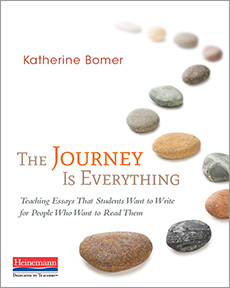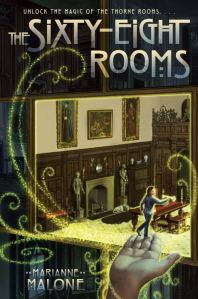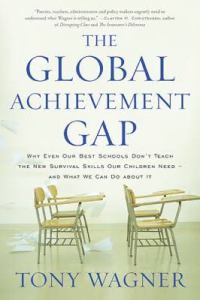CGTI – The Community Action Team
This is the second in a series of blog posts that will be showing up over the next several days related to my recent experiences at the Cebrin Goodman Teen Institute held at Eastern Illinois University in Charleston, Illinois on July 17-21. (In the past, I have written about the Teen Institute on my personal blog. This year I have decided to share my reflections on this blog instead.) For those who are not aware, CGTI is a week-long leadership camp for middle and high school students that focuses on developing leadership skills, taking healthy risks, learning about the dangers of alcohol, tobacco, and other drugs (ATODs), and working in action teams to bring about positive change in the community. Instead of breaking down the posts day by day, I have decided to reflect topically. Today I want to reflect on the heart and soul of the Teen Institute: Community Action Teams.
Book Review: The Journey Is Everything
About two months ago, I received a flyer in the mail from an education publishing company that came to me as a byproduct of my membership in the National Council of Teachers of English. The flyer was about a new book coming out in May called The Journey Is Everything: Teaching Essays That Students Want to Write for People Who Want to Read Them by Katherine Bomer.
The title alone captured my interest. Having a father-in-law who is a college English professor who wants posted a satirical video of himself tearing up papers and crying out “Crap! Garbage! Terrible!” while grading student essays and having a brother who is also a college English professor who has engaged me in countless discussions of the horrors of the five-paragraph essay/theme, I wanted to know what Ms. Bomer had to say about this topic. Fortunately for me, the publisher provided a link to their website where I could read an excerpt from the introduction. A table of contents and five pages later, and I knew that this was a book I would want to read.
Around the same time, I bumped into my district’s director of professional development and started talking about book studies and PD offerings for the coming year. I told her about this book and suggested that, building on my district’s recent work on improving writing instruction (I happen to be on the writing committee), this might be a great addition. The tricky part, however, was that the book had just been published, and I was uneasy about suggesting a book study on a book nobody had read. (After all, what if the book turned out to be awful and the introduction was just a ploy to get unwitting teachers to buy another book with a pretty cover?) No problem, she told me. She would order a copy for me so I could read it over the summer.
Have I mentioned recently how much I love my school district and the willingness of district leaders to encourage teachers to take leadership in providing worthwhile professional development?
The book came in my mailbox a few weeks later and was put near the top of my To Be Read pile. When I was later emailed to submit a formal request to lead the PD session in the fall, I realised I needed to bump the book to the top of the pile. I started reading it about two or three weeks ago and finished today. I would have finished sooner but I found I needed to be able to highlight and annotate as I read, so I couldn’t read while eating and before going to sleep.
Oh, by the way: I hate highlighting books. And I hate writing in the margins. I have rejected copies of highly-desired books simply because they have a note in the margin here and there. My copy of this book? Highlighted and annotated on nearly every page.
There is no way I can give justice to this entire book in a single blog post. There is also no way that I can select one or two quotes to capture the essence of the argument Ms. Bomer makes. However, I will say this: The five-paragraph essay is arguably the worst formula ever conceived for teaching students how to write. (It is an artificial structure and the product isn’t even really an essay.) Essay writing should be a journey for the author who is writing to think and discovering meaning in text and in the world. If we are serious about wanting to teach students how to express their thoughts, we need to stop trying to force those thoughts to conform to a rigid introduction/thesis/support/conclusion structure. Think about this: when is the last time you read something in that format that moved you to think, to consider, to change, to act? I know my answer: never.
Instead of relying on this old-but-terrible formula, essay writing needs to be open to exposing the soul of the writer. To quote Ms. Bomer who was referencing another researcher, “essays feel like gritos to me: soulful, aching cries in the wilderness of surprise, joy, anger, grief, freedom, and celebration. I want children to be able to put their particularly cries, their gritos, into the world and for the world to read them and respond. Why would we deny our students the ability to be soulful and beautiful?”
Why, indeed.
Book Review: The Sixty-Eight Rooms
When I first started teaching at Wiley, I heard about an off-campus learning experience that our fifth graders got to do called KAM-WAM. This was an opportunity for the students to spend a week at the Krannert Art Museum, learning about art and history and literature and movement and light and so many other things. As part of this project, most of the students would be reading the book Chasing Vermeer by Blue Balliett, Some of the students would read a similar book by Marianne Malone called The Sixty-Eight Rooms. This latter book floated in the background of my mind for several years until last year when I met the author at the Illinois Young Authors Conference in Bloomington. Hearing her talk about the book and some of the processes involved in writing it piqued my interest and I purchased a copy (which I also got autographed, of course).
As with so many other books, this went on my To Be Read pile by my bed but then stayed there for months as new books went on top and other obligations got in the way. I finally read it this summer and quite thoroughly enjoyed it. This is the first in a series of books that incorporate a theme of magic in modern days along with interesting art history.
What I found most intriguing in this story was the incorporation of the Thorne Rooms at the Art Institute of Chicago. I have only been to the Art Institute once in my entire life but now I very much want to go again so I can visit the exhibit and share in the wonder of the miniature rooms that Mrs. James Ward Thorne created to represent, on a scale of one inch to one foot, everyday life from Europe and America.
The characters from this story are equally compelling and I found myself wanting to cheer when they solved a problem, hug them when challenges were overcome, and laugh when they shared secret jokes that, as a reader, I was in on.
If I ever have the opportunity to bring a class to the Art Institute of Chicago, I will make sure that they have read this book first and come to the exhibit prepared to question, to wonder, and to observe. And if I am unable to bring my students to the Art Institute, I would find a way to bring the Art Institute to them!
Book Review: The Global Achievement Gap
For the past several years, I have had the opportunity to accompany my mother to the Joint Annual Conference of the Illinois Association of School Boards, the Illinois Association of School Administrators, and the Illinois Association of School Business Officials (often called the Triple I conference or just the Joint Annual Conference because JACIASBIASAIASBO doesn’t really roll of the tongue as a word.) The first year I went, one of the keynote speakers with Dr. Tony Wagner, who was invited to share his research findings on what skills students need to be prepared for college or careers.
Now, college and career readiness are hot topics in education. In fact, the driving goal behind the Common Core State Standards was a realisation that the standards many states had for K-12 education were far below what students needed to succeed in life after school. (In addition to the huge inequity of learning gaps when a student moved from one state to another and had to change to a completely different curriculum designed around a very different set of learning standards.)
I was captivated by Dr. Wagner’s remarks because his focus wasn’t on content; it was on capacity. Rather than tell us what math skills students needed or what specific historical dates were universally necessary, he told the audience that what college admissions directors, college professors, human resources departments, military leaders, and entrepreneurs were really looking for were for adults who knew how to think and how to solve problems. Specifically, he identified seven skills that he referred to as the Seven Survival Skills:
- Critical thinking and problem solving
- Collaboration across networks and leading by influence
- Agility and adaptability
- Initiative and entrepreneurship
- Effective oral and written communication
- Accessing and analyzing information
- Curiosity and imagination
Dr. Wagner has written a number of books related to these Survival Skills. For many years now, these have been on my list of books To Be Read (although, actually, they were also on my list of Books To Acquire.) I finally got a couple of these books this past year for Christmas and my birthday and was excited to read them. However, with the pressure of finishing my master’s degree program and teaching and finding time to be with family and friends, these books languished in my pile for quite a long time.
I made a goal to tackle this pile during the summer. Instead of reading, researching, and writing for graduate school, I am taking three hours every day to read for myself. Some of the books are work-related, some are purely for fun, all of them are for personal reasons. As I have read the professional books, I have posted quotes and reflections on my personal Facebook account, using the book titles as a hashtag so I can go back and search them. I wanted to share a few highlights here.
First, however, I think it is worth noticing the premise of his book’s title: students in the United States are often out-performed by students in other, similarly developed nations. There is a real and definable gap between American student achievement and student achievement across the globe. Dr. Wagner does not rely on traditional high-stakes standardised tests to draw these conclusions, though; in fact, he opposes such tests and advocates against them. At the same time, he advocates for assessments that, according to his research, are more meaningful. These assessments are performance based. Instead of a bunch of multiple choice questions that require rote memorisation and recall, performance-based assessments demand students explain their thinking, show their processes, and find multiple paths to a problem. (Incidentally, this is a the theoretical goal behind the new PARCC assessments we are using in Illinois; whether or not these tests will hit the target is still be determined.) So, knowing that the “global achievement gap” relates to the poor outcomes of our students students on such performance-based assessments, here are some suggestions to close the gap:
“The rigor that matters most for the twenty-first century is demonstrated mastery of the core competencies for work, citizenship, and life-long learning. Studying academic content is the means of developing competencies, instead of being the goal, as it has been traditionally. In today’s world, it’s no longer how much you know the matters; it’s what you can do with what you know.”
When I need to know something that isn’t readily accessed in my memory, I pull out my phone and I look it up. This requires three things: first, access to the technology to acquire the information; second, knowledge of how to ask the right question; and third, how to interpret the information that I find. If all I am doing is teaching my students how to recall information I have presented them, I am not teaching with the rigor necessary for them to be successful in life after fourth grade, life after public school, life after college, etc. This is a good reminder for me that academic content is the means, not the aim.
“We know that isolation is the enemy of improvement in education–and in all other professions– and that working more collaboratively to improve teaching and learning is really the only way educators are likely to get significantly better results. We also know that educators must be accountable for how they use their time and be able to show that students are learning more–including more of the content that really matters. What we don’t yet know is whether American taxpayers and our government care enough about the future to pay educators a more professional wage and to provide them with the working conditions they need to succeed: smaller classes, teachers organized into teams with shared responsibility for groups of students, more effective coaching for continuous improvement, better and more frequent local assessments of students’ progress, and more time to work and learn with colleagues.”
If I arrive at work at 7:30 am, close my door, and only open it when students are entering or leaving until it is time for me to go home at the end of the day, I am not doing what’s necessary to be a successful teacher. If the only time I speak to my colleagues is during lunch to talk about the latest political controversy of the day or staff meetings to talk about data that has given us, I am not going to grow as an educator. If I am not willing to be vulnerable when my principal comes to observe me, to seek out feedback to improve, then, surprise, surprise, I’m not going to improve. As my graduate advisor was so fond of telling us, gone are the days of the teacher-as-independent-contractor. We must work together, we must talk together, we must learn together. I am proud to work in a district that fosters this kind of collaboration. I love and respect my colleagues who are interested in learning together. Our lunch time conversations often turn to what we can do to help our students. Our staff meetings are opportunities to come together as a team to do what’s best for our students and their families. And as another education researcher has said, if we aren’t focusing on what’s best for students, then what are we doing in the classroom?
“… the future of our economy, the strength of our democracy, and perhaps even the health of the planet’s ecosystems depend on educating future generations in ways very different from how many of us were schooled.”
This last really struck a nerve with me. So much of the opposition I hear from others whenever we propose change in our schools is something along the lines of “If it was good enough for me, it should be good enough for the students.” This just isn’t true. The world has changed drastically over the past few decades. “Good enough” is never good enough. I often tell my students that my job isn’t to get them to the end of fourth grade; my job is to get them on the path of lifelong learning. Specifically, my job is to help them learn how they learn so that they can learn without anyone telling them what to learn. Education is the long game writ large. The problems of tomorrow will only be solved by the generation that knows how to look forward. As we make this our focus, we will see the global achievement gap close and find our economy, our democracy, and our planet improve.
It’s a lofty goal and it may take generations to achieve. But you know what? If we don’t start now, it is going to take even longer.






